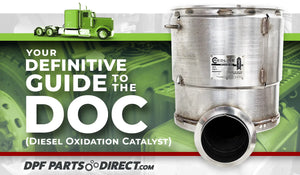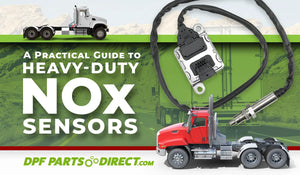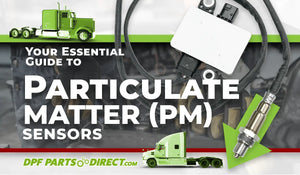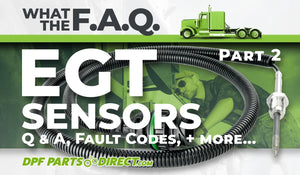Nox Sensor
When a nitrogen oxide sensor fails on a truck with a diesel engine, bad things start to happen. The motor may begin to run rough and fuel consumption can drastically increase. Next, the motor may go into derate, or “limp mode,” and finally, the truck may break down and stop running altogether. The nitrogen oxide sensor is not the part of vehicles you want to fail.
Exhaust gas nitrogen oxide sensors were first developed in the 1990s and were introduced in automotive vehicles and applications in the early 2000s. They were originally used in stratified charge gasoline passenger cars with nitrogen oxide absorbers, then in automotive applications with diesel engines. In 2007, the HB2007 law was passed and medium and heavy-duty trucks with diesel motors that use urea-SCR aftertreatment system required nitrogen oxide sensors as well.
What is a NOx levels sensor?
A nitrogen oxide sensor is a high-temperature device built with intricate technology to detect nitrogen oxides in the air, ammonia concentrations, and emissions regulations in combustion environments, such as in the exhaust of a truck with a diesel motor. The temperature detection on this device is imperative for its level of effectiveness.
How does a NOx sensor work?
Modern class eight commercial trucks with diesel motors are now manufactured with on-board diagnostic systems. When the nitrogen oxide sensor detects excessive nitrogen oxide or ammonia at a specific temperature with the Selective Catalytic Reduction (SCR) outlet, a fault code will be triggered as a catalyst through the on-board diagnostics and an alert will appear in a display visible to the driver.
Why do I need a NOx sensor?
Certain gasses, including carbon dioxide, methane, and nitrogen oxides are the catalyst to atmospheric pollution. Nitrogen oxide contributes to the production of ozone or smog and can also cause lung damage. One of the biggest sources of nitrogen oxide pollution is diesel motors.
In 2007 and 2010 regulations were placed on the emissions from diesel motors. The goal was to detect and reduce nitrogen oxide pollution by 90% which was accomplished with the current vehicle diesel emissions regulations systems that are installed on all diesel motors. There is a new proposal by California Air Resources Board (CARB) and the Environmental Protection Agency (EPA) to reduce the remaining nitrogen oxide emissions by a further 90% by 2027. This will lower nitrogen oxide limits to as low as 0.015 g/bhp-hr. This proposal will require sensors to be enhanced to detect lower levels of nitrogen oxide and to be able to perform over the entire duty cycle of these commercial work trucks consistently and accurately.
Is the NOx sensor the same as a Lambda (Oxygen) Sensor?
The short answer is NO. While one component measures oxygen gas, the other measures nitrogen oxide gas. Both are valuable in their own way.
Both of these sensors are located on the exhaust pipe of vehicles and can even look similar to each other, but they perform different functions of operation and offer different benefits, including how they measure different fuel and gas types.
The Lambda, or Oxygen, component sends information to the ECU about the concentration of oxygen in the exhaust gas that impacts the amount of fuel being injected into the cylinders. Too much oxygen or too little oxygen can pose potential issues. The NOx component detects the amount of nitrogen oxide in the exhaust gas and this controls the amount of urea injection in the diesel emissions system.
Where is the NOx sensor located?
The location of the nitrogen oxide sensor is typically installed Pre and Post the SCR Filter, which is normally the last part of the after-treatment system. The upstream nitrogen oxide component location and downstream nitrogen oxide sensor location is going to be different depending on the truck.
For example, on a 2016 Kenworth T680 with a Cummins ISX15 vehicle motor, the upstream nitrogen oxide component location is on the passenger side of the motor, right after the turbo on the inlet side of the Selective Catalytic Reduction (SCR). The downstream nitrogen oxide component is located behind the cab, you have to go under the truck, and you will see the SCR on the left with the exhaust coming out of it. The NOx levels sensor is located on the outlet side of the SCR and is almost immediately after the SCR.
On a 2013 Freightliner Cascadia with a Detroit Diesel motor and a One Box configuration for the diesel emissions system, you have to remove the passenger side steps. The sensors are located side by side, you use an E10 Inverted Torx Socket to remove the bolt holding the bracket in place. When you follow the wires you will find the upstream nitrogen oxide component on top of the box on the inlet side of the SCR, the downstream nitrogen oxide component is under the truck, behind the box on the outlet side of the SCR.
What happens if my NOx sensor is faulty?
When a NOx sensor is faulty, there are several things that will happen. While this isn't typically a common issue, it's one to pay attention to and valuable information to know. One of the first indications of a faulty NOx levels component is a change in fuel consumption. If all of a sudden you are burning a lot more diesel fuel this can be an indication that you have a faulty nitrogen oxide sensor.
Another sign that you could have a faulty nitrogen oxide technology sensor is the diesel motor running really rough. Of course, there are many reasons that a diesel motor is running rough so make sure that you do a proper diagnostic of the engine to positively identify the cause.
Finally faulty sensors have been known to put the engine into derate or “limp mode”, if this happens you will need to visit a repair shop as quickly as possible to diagnose and replace the faulty NOx component. Ignoring these symptoms of a faulty nitrogen oxide sensor can lead to a complete breakdown where a mobile repair service or a tow truck is needed so it is best to address this issue as soon as possible to avoid the high price of unscheduled downtime and a roadside repair event.
Why did my NOx sensor stop working?
There are many reasons for a NOx sensor becoming faulty. We have found that the most common reason is that a vehicle owner has replaced an NOx component with a low-quality replacement part.
Cheap Low-Quality Replacement Parts
There are many aftermarket options, some meet and even exceed the Original Equipment Manufacturers specifications, but there are many “knock offs” that are manufactured with components that just don’t stand up to the environments commercial trucks operate in here in North America.
Saving a few dollars on a cheap low-quality NOx sensor, only to spend hundreds or even thousands of dollars on a second repair makes no sense at all, but sadly many vehicle owners have been tempted by that low initial purchase price and been burned.
Heavy-Use and Age
NOx sensors are exposed to the elements and a high-heat environment. While high-quality NOx sensors are designed to stand up to these conditions, they will not last forever and will eventually need to be replaced.
Usually, the issue is a build up of soot or dirt on the sensor. Eventually the sensor will no longer be able to operate properly, and the contaminants will prevent the sensor from detecting NOx in the system which will trigger a fault code.
All of those contaminants are abrasive, and over time the sensor may experience water intrusion which then damages the internal components of the sensor and then it will fail and need to be replaced.
How to clean a NOx sensor?
One thing to remember is that the NOx sensor cannot distinguish the difference between elevated NOx and ammonia in the system. Ammonia is a byproduct of the DEF being injected into the system and not being burned off during the regeneration process. One solution to this is the perform a regen to clear any ammonia out of the exhaust system. If you continue to get a fault code after the regen has been performed, then you have a faulty NOx sensor, and it will need to be replaced.
How much does a NOx sensor cost?
As with any heavy-duty replacement part for a commercial truck with a diesel motor, the price of the parts can be quite different depending on where you are buying the parts, who manufactured them in their development, and who is selling them in the market. OEM NOx sensors typically range from $450.00 to $750.00 or higher and high-quality aftermarket replacement parts like the sensors manufactured by Redline Emissions Products and sold on DPFPartsDirect.com typically range from $250.00 to $750.00.
If you find a NOx sensor for much less than these prices, please be very careful. It is probably a low-quality NOx sensor that does not meet OEM specifications and will cost you much more when it fails prematurely.
Are NOx sensors universal or engine specific?
NOx sensors are specific to the motor and even specific to the motor configuration development, including horsepower and exhaust location, which are specified by the truck manufacturer on the market. This means that you could buy two trucks that are the same year, make, and model but depending on how they are configured could utilize different NOx sensors.
This is further complicated because motor manufacturers have partnered with or acquired each other. An example of this is the NOx sensor that is manufactured for Detroit Diesel engines that are commonly found in both Freightliner and Mercedes applications.
Where to get a replacement diesel NOx sensor
DPFPartsDirect.com sells high-quality replacement NOx sensors that fit as well or better than OEM for all the major diesel engine brands including Cummins, Detroit Diesel, Hino, Isuzu, Navistar, PACCAR, and Volvo.
When you shop online and buy NOx sensors from DPFPartsDirect.com you will gain access to a huge inventory of after-treatment parts that are manufactured to meet or exceed OE specifications. All parts sold include OE and cross-reference part numbers on the label so you can be absolutely sure that you have purchased the correct NOx sensor for your application.
If you are unsure of which NOx sensor you need or require assistance with replacing your NOx sensor or any other after-treatment products you can call us toll free at 1-844-394-4590 or use our online chat for customer support.










Comments 0